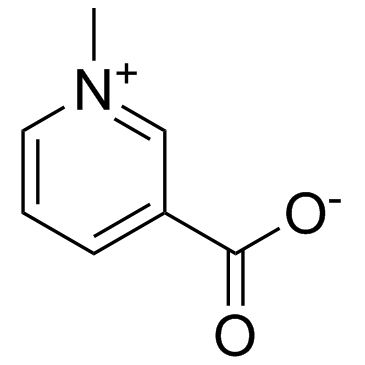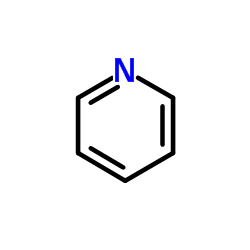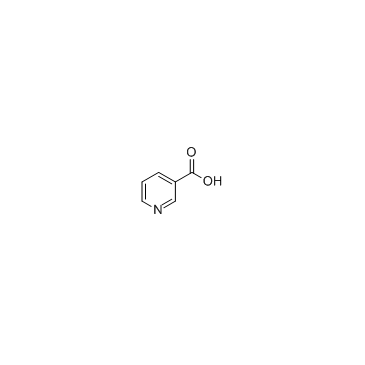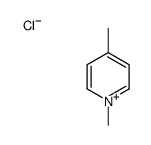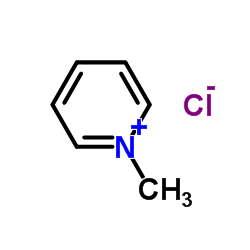6138-41-6
| 中文名 | 盐酸胡芦巴碱 |
|---|---|
| 英文名 | Trigonelline hydrochloride |
| 中文别名 |
N-甲基烟酸内盐盐酸盐
胡芦巴碱盐酸盐 盐酸葫芦巴碱葫芦巴碱盐酸盐、N-甲基烟酸内盐盐酸盐 盐酸葫芦巴碱 葫芦巴碱盐酸盐 胡卢巴碱盐酸盐 胡芦巴碱盐酸盐 |
| 英文别名 |
Pyridinium, 3-carboxy-1-methyl-, chloride (1:1)
3-Carboxy-1-methylpyridinium chloride Trigonelline hydroch TRIGONELLINE HCL trigonellinium chloride 1-Methyl-3-pyridiniumcarboxylathydrochlorid TRIGONELLIN HYDROCHLORIDE 1-Methylpyridinium-3-carboxylate hydrochloride (1:1) EINECS 228-119-5 N-METHYLNICOTINIC ACID BETAINE HYDROCHLORIDE 1-Méthyl-3-pyridiniumcarboxylate chlorhydrate 1-methylnicotinic acid chloride Pyridinium, 3-carboxy-1-methyl-, chloride N-methylpyridinium-3-carboxylate hydrochloride 1-Methyl-3-pyridiniumcarboxylate hydrochloride MFCD00077250 Trigonelline chloride |
| 描述 | Trigonelline chloride 是一种大量存在于咖啡中并且具有潜在抗糖尿病活性的生物碱。 |
|---|---|
| 相关类别 | |
| 体外研究 | 发现氯化三氟苯胺(TG)显着地挽救了H9c2细胞的形态。用盐酸葫芦巴碱处理细胞减弱H2O2诱导的细胞死亡并改善抗氧化活性。此外,在H2O2诱导的H9c2细胞氧化应激过程中,Trigonelline chloride调节凋亡基因caspase-3,caspase-9和抗凋亡基因Bcl-2,Bcl-XL。显而易见,流式细胞仪结果也证实了氯化三叶草可显着降低H2O2诱导的H9c2细胞坏死和凋亡。然而,三氯化萘氯化物浓度对H2O2的进一步增加可以诱导H2O2的坏死和凋亡[1]。 |
| 体内研究 | 氯化葫芦巴碱降低骨矿化并且趋向于恶化链脲佐菌素诱导的糖尿病大鼠的骨机械性质。在烟酰胺/链脲佐菌素处理的大鼠中,盐酸葫芦巴碱显着增加骨矿物质密度(BMD)并倾向于改善松质骨强度。 Trigonelline chloride对链脲佐菌素诱导的代谢紊乱大鼠的骨骼系统有不同的影响,强化链脲佐菌素处理大鼠的骨质疏松变化,并有利地影响非高血糖(烟酰胺/链脲佐菌素处理)大鼠的骨骼[2]。 |
| 细胞实验 | 将H9c2细胞以1×10 5个细胞/孔的密度接种在96孔中。用不同浓度的三叶草甙(TG)(25至150μM)和过氧化氢(25至125μM)处理细胞。将其在37℃,5%CO 2培养箱中孵育24小时和6小时,然后用水溶性四唑(WST)试剂处理培养物,孵育2小时至4小时。活细胞吸收WST,然后转化为橙色产品。然后,使用光谱计数ELISA读数器在450nm处测量颜色强度。对于心脏保护活性,将细胞接种并分成六组:对照,单独的H2O2,其余组最初暴露于不同浓度(25至125μM)的盐酸葫芦巴碱48小时。然后,加入100μMH2O2并孵育4小时,之后,读取450nm处的吸光度用于细胞活力测定[1]。 |
| 动物实验 | 在该研究中使用3个月大的雌性Wistar大鼠。将动物分成5组(n = 10):对照大鼠,链脲佐菌素处理的对照大鼠,接受链脲佐菌素处理的大鼠(每天50mg / kg口服),烟酰胺/链脲佐菌素处理的对照大鼠和烟酰胺/链脲佐菌素 - 接受处理的大鼠接受盐酸Trigonelline(每天50mg / kg po)。在链脲佐菌素后两周开始施用盐酸葫芦巴碱并持续四周。每天一次通过胃管给予盐酸葫芦巴碱。所有对照大鼠以2mL / kg po的相同体积接受自来水(载体)。施用四叶碱氯化物的四周时间足以证明三叶草氯化物和植物来源的其他化合物在大鼠中的骨骼效应。在最后的氯化噻吩氯化物或载体给药后,将大鼠禁食过夜。第二天,测量血糖水平,用氯胺酮和甲苯噻嗪麻醉大鼠,然后通过心脏放血处死[2]。 |
| 参考文献 |
| 熔点 | ~260 °C (dec.) |
|---|---|
| 分子式 | C7H8ClNO2 |
| 分子量 | 173.597 |
| 精确质量 | 173.024353 |
| PSA | 44.01000 |
| 外观性状 | 固体;White to Almost white powder to crystal |
| 储存条件 | -20°C |
| 水溶解性 | 水溶性:可溶 |
| 计算化学 | 1、 氢键供体数量:1 2、 氢键受体数量:3 3、 可旋转化学键数量:1 4、 拓扑分子极性表面积(TPSA):41.2 5、 重原子数量:11 6、 表面电荷:0 7、 复杂度:136 8、 同位素原子数量:0 9、 确定原子立构中心数量:10 10、 不确定原子立构中心数量:0 11、 确定化学键立构中心数量:0 12、 不确定化学键立构中心数量:0 13、 共价键单元数量:2 |
| 更多 | 1. 性状:未确定 2. 密度(g/mL, 20 ℃ ):未确定 3. 相对蒸汽密度(g/mL,空气=1):未确定 4. 熔点(ºC):~260 5. 沸点(ºC,常压):未确定 6. 沸点(ºC,13mmHg):未确定 7. 折射率:未确定 8. 闪点(ºC):未确定 9. 比旋光度(º):未确定 10. 自燃点或引燃温度(ºC):未确定 11. 蒸气压(kPa,25ºC):未确定 12. 饱和蒸气压(kPa,60ºC):未确定 13. 燃烧热(KJ/mol):未确定 14. 临界温度(ºC):未确定 15. 临界压力(KPa):未确定 16. 油水(辛醇/水)分配系数的对数值:未确定 17. 爆炸上限(%,V/V):未确定 18. 爆炸下限(%,V/V):未确定 19. 溶解性:未确定 |
|
SECTION 1: Identification of the substance/mixture and of the company/undertaking Product identifiers Product name: Trigonelline hydrochloride REACH No.: A registration number is not available for this substance as the substance or its uses are exempted from registration, the annual tonnage does not require a registration or the registration is envisaged for a later registration deadline.
CAS-No.: 6138-41-6 Relevant identified uses of the substance or mixture and uses advised against Identified uses: Laboratory chemicals, Manufacture of substances SECTION 2: Hazards identification Classification of the substance or mixture Not a hazardous substance or mixture according to Regulation (EC) No. 1272/2008. This substance is not classified as dangerous according to Directive 67/548/EEC. Label elements The product does not need to be labelled in accordance with EC directives or respective national laws. Other hazards - none SECTION 3: Composition/information on ingredients Substances Synonyms: 1-Methylpyridinium-3-carboxylatehydrochloride N-Methylnicotinic acid betainehydrochloride Formula: C7H7NO2 · HCl Molecular Weight: 173,60 g/mol CAS-No.: 6138-41-6 EC-No.: 228-119-5 No components need to be disclosed according to the applicable regulations. SECTION 4: First aid measures Description of first aid measures If inhaled If breathed in, move person into fresh air. If not breathing, give artificial respiration. In case of skin contact Wash off with soap and plenty of water. In case of eye contact Flush eyes with water as a precaution. If swallowed Never give anything by mouth to an unconscious person. Rinse mouth with water. Most important symptoms and effects, both acute and delayed The most important known symptoms and effects are described in the labelling (see section 2.2) and/or in section 11 Indication of any immediate medical attention and special treatment needed no data available SECTION 5: Firefighting measures Extinguishing media Suitable extinguishing media Use water spray, alcohol-resistant foam, dry chemical or carbon dioxide. Special hazards arising from the substance or mixture Carbon oxides, nitrogen oxides (NOx), Hydrogen chloride gas Advice for firefighters Wear self contained breathing apparatus for fire fighting if necessary. Further information no data available SECTION 6: Accidental release measures Personal precautions, protective equipment and emergency procedures Avoid dust formation. Avoid breathing vapours, mist or gas. For personal protection see section 8. Environmental precautions Do not let product enter drains. Methods and materials for containment and cleaning up Sweep up and shovel. Keep in suitable, closed containers for disposal. Reference to other sections For disposal see section 13. SECTION 7: Handling and storage Precautions for safe handling Provide appropriate exhaust ventilation at places where dust is formed.Normal measures for preventive fire protection. For precautions see section 2.2. Conditions for safe storage, including any incompatibilities Store in cool place. Keep container tightly closed in a dry and well-ventilated place. Specific end use(s) Apart from the uses mentioned in section 1.2 no other specific uses are stipulated SECTION 8: Exposure controls/personal protection Control parameters Components with workplace control parameters Exposure controls Appropriate engineering controls General industrial hygiene practice. Personal protective equipment Eye/face protection Use equipment for eye protection tested and approved under appropriate government standards such as NIOSH (US) or EN 166(EU). Skin protection Handle with gloves. Gloves must be inspected prior to use. Use proper glove removal technique (without touching glove's outer surface) to avoid skin contact with this product. Dispose of contaminated gloves after use in accordance with applicable laws and good laboratory practices. Wash and dry hands. The selected protective gloves have to satisfy the specifications of EU Directive 89/686/EEC and the standard EN 374 derived from it. Body Protection Choose body protection in relation to its type, to the concentration and amount of dangerous substances, and to the specific work-place., The type of protective equipment must be selected according to the concentration and amount of the dangerous substance at the specific workplace. Respiratory protection Respiratory protection is not required. Where protection from nuisance levels of dusts are desired, use type N95 (US) or type P1 (EN 143) dust masks. Use respirators and components tested and approved under appropriate government standards such as NIOSH (US) or CEN (EU). Control of environmental exposure Do not let product enter drains. SECTION 9: Physical and chemical properties Information on basic physical and chemical properties a) AppearanceForm: crystalline Colour: white b) Odourno data available c) Odour Thresholdno data available d) pHno data available e) Melting point/freezingMelting point/range: 260 °C point f) Initial boiling point and no data available boiling range g) Flash pointno data available h) Evapouration rateno data available i) Flammability (solid, gas) no data available j) Upper/lowerno data available flammability or explosive limits k) Vapour pressureno data available l) Vapour densityno data available m) Relative densityno data available n) Water solubilityno data available o) Partition coefficient: n- no data available octanol/water p) Auto-ignitionno data available temperature q) Decompositionno data available temperature r) Viscosityno data available s) Explosive propertiesno data available t) Oxidizing propertiesno data available Other safety information no data available SECTION 10: Stability and reactivity Reactivity no data available Chemical stability Stable under recommended storage conditions. Possibility of hazardous reactions no data available Conditions to avoid no data available Incompatible materials Strong oxidizing agents Hazardous decomposition products Other decomposition products - no data available In the event of fire: see section 5 SECTION 11: Toxicological information Information on toxicological effects Acute toxicity no data available Skin corrosion/irritation no data available Serious eye damage/eye irritation no data available Respiratory or skin sensitisation no data available Germ cell mutagenicity no data available Carcinogenicity IARC:No component of this product present at levels greater than or equal to 0.1% is identified as probable, possible or confirmed human carcinogen by IARC. Reproductive toxicity no data available Specific target organ toxicity - single exposure no data available Specific target organ toxicity - repeated exposure no data available Aspiration hazard no data available Additional Information RTECS: Not available To the best of our knowledge, the chemical, physical, and toxicological properties have not been thoroughly investigated. SECTION 12: Ecological information Toxicity no data available Persistence and degradability no data available Bioaccumulative potential no data available Mobility in soil no data available Results of PBT and vPvB assessment PBT/vPvB assessment not available as chemical safety assessment not required/not conducted Other adverse effects no data available SECTION 13: Disposal considerations Waste treatment methods Product Offer surplus and non-recyclable solutions to a licensed disposal company. Contaminated packaging Dispose of as unused product. SECTION 14: Transport information UN number ADR/RID: -IMDG: -IATA: - UN proper shipping name ADR/RID: Not dangerous goods IMDG: Not dangerous goods IATA:Not dangerous goods Transport hazard class(es) ADR/RID: -IMDG: -IATA: - Packaging group ADR/RID: -IMDG: -IATA: - Environmental hazards ADR/RID: noIMDG Marine pollutant: noIATA: no Special precautions for user no data available SECTION 15: Regulatory information This safety datasheet complies with the requirements of Regulation (EC) No. 1907/2006. Safety, health and environmental regulations/legislation specific for the substance or mixture no data available Chemical Safety Assessment For this product a chemical safety assessment was not carried out SECTION 16: Other information Further information Copyright 2014 Co. LLC. License granted to make unlimited paper copies for internal use only. The above information is believed to be correct but does not purport to be all inclusive and shall be used only as a guide. The information in this document is based on the present state of our knowledge and is applicable to the product with regard to appropriate safety precautions. It does not represent any guarantee of the properties of the product. Corporation and its Affiliates shall not be held liable for any damage resulting from handling or from contact with the above product. See and/or the reverse side of invoice or packing slip for additional terms and conditions of sale. |
| 个人防护装备 | Eyeshields;Gloves;type N95 (US);type P1 (EN143) respirator filter |
|---|---|
| 危害码 (欧洲) | Xi |
| 风险声明 (欧洲) | R36/37/38 |
| 安全声明 (欧洲) | S22-S24/25 |
| 危险品运输编码 | NONH for all modes of transport |
| WGK德国 | 3 |
| 海关编码 | 2933399090 |
|
~% 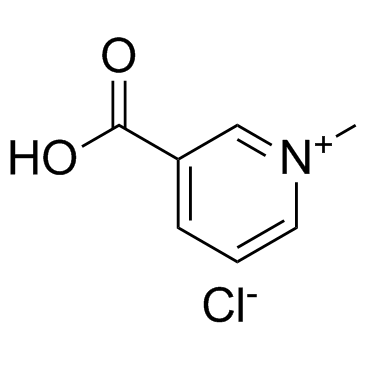
6138-41-6 |
| 文献:US2008/221173 A1, ; Page/Page column 6-7 ; |
|
~% 
6138-41-6 |
| 文献:Journal of Pharmaceutical Sciences, , vol. 82, # 8 p. 782 - 786 |
| 海关编码 | 2933399090 |
|---|---|
| 中文概述 | 2933399090. 其他结构含非稠合吡啶环的化合物. 增值税率:17.0%. 退税率:13.0%. 监管条件:无. 最惠国关税:6.5%. 普通关税:20.0% |
| 申报要素 | 品名, 成分含量, 用途, 乌洛托品请注明外观, 6-己内酰胺请注明外观, 签约日期 |
| Summary | 2933399090. other compounds containing an unfused pyridine ring (whether or not hydrogenated) in the structure. VAT:17.0%. Tax rebate rate:13.0%. . MFN tariff:6.5%. General tariff:20.0% |


